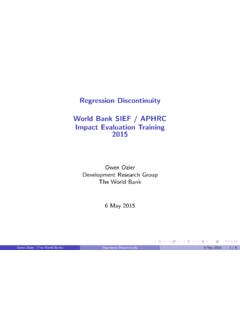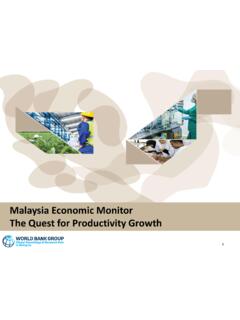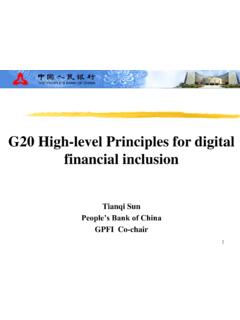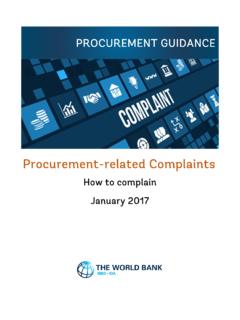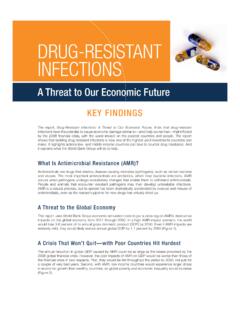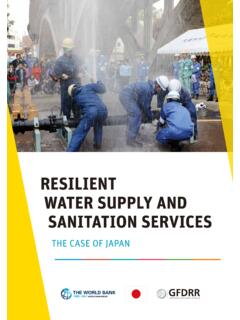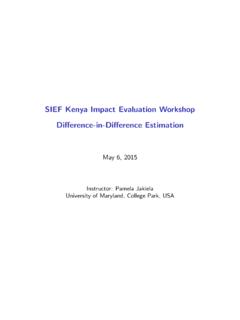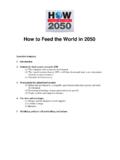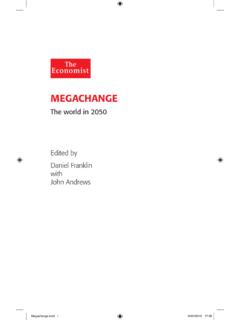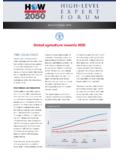Transcription of Farming for the Future - World Bank
1 Farming for the Future m the environmental sustainability of agriculture in a changing World Holger A. Kray Lead Agriculture Economist The Global Food System in 2050 35% increase in food production by 2030 (FAO) income growth per year for smallholders farmers in poorer countries (to end poverty) Improved health outcomes - Reduced undernourishment and child stunting - Reduced obesity Sustainable use of natural resources land, water, biodiversity, atmosphere 2012 2050 Needed from the Global Food System +50% Food demand 7 billion people 9 billion people Projected Trends Will Not Get Us There Increase in Food Production (%) by 2030 Income Increase to 2030 (% per year) Health Outcomes (bn people) by 2030 GHG Emissions from Agriculture (% change) by 2030 +20%* +35% TrendVision+13%* -25% * * TrendVision* is 10 yr trend growth (2003-2012) of agricultural labor productivity in low income countries projected forward to 2030; is estimated agricultural incomes gains of the poor needed to end poverty by 2030.
2 * Trend assumes a 2oC warmer World by 2030 and an associated 10% reduction in food crop yields * Trend assumes 8% undernourishment rate and bn people in developing countries by 2030, Vision is 3%. * Trend: WRI estimates TrendVisionUndernourishedObeseThree Challenges PRODUCTIVITY Feeding 9 Billion People in 2050 Food Production by Region 1972-2050 (Constant 2004-06 US$) Food Demand By Commodities in 2050 relative to 2005 -07 (Billion kg per year) Asia Latin America Africa Europe North America 05001,0001,5002,0002,5003,0003,5004,0001 972198219922002201220302050 Oceania 1 CEA 2013 based on FAO 2012 ADAPTATION Climate Change Impacts on Food Systems Problems Today: Short Term Volatility Issues Tomorrow: Medium Term Yield Losses and Increasing Cost Structures Recent price spikes for food commodities have been linked to extreme weather events Maize and wheat yields show climate impacts Uncertain Future : Production Collapse in the Longer Term Maize and wheat yields show climate impacts 2 CCAFS 2014.
3 World Bank 2008 Electricity & Heat Production 25% Other Energy Industry 21% Transport 14% Buildings Land Use Change 11% Agriculture 13% EMISSIONS Agriculture: Today LIVESTOCK 62% AGRICULTURE ~13% OF TOTAL LAND USE CHANGE ~11% OF TOTAL TOTAL EMISSIONS FERTILIZATION 16% RICE - 10% OTHER - 12% FOREST LAND 63% CROPLAND 25% BURNING BIOMASS 11% 3a IPCC 2014 EMISSIONS Agriculture: Tomorrow Gt LULUCF* Gt Agriculture Gt Agriculture 4 Gt Agriculture Gt LULUCF* By 2050, Agriculture and Land Use Change could represent 70% of Global Emissions - if global emissions are reduced in accordance with a 2C goal, while Agriculture were to remain in business as usual. By 2050, Agriculture will therefore have to reduce its emission intensity by 60%, if it is to maintain its footprint in parallel with overall emissions reductions. This already assumes emissions from Land Use Change will have fallen to zero. Projections of Global, Agriculture and Land Use Change Related Emissions towards 2050 (Gt CO2e) - Gt TODAY 2050 2C Ensuring Emission Level *Land Use, Land Use Change and Forestry 11% 14% Global Emissions: Gt Global Emissions: 21-22 Gt Global Emissions: 21-22 Gt ~25% of Total 25% 45% ~70% of Total 60% GAP Agriculture Business As Usual Ag.
4 Reduces Proportional to Other Sectors 1 2 1 2 3b WRI 2013 Solutions 11 INCREASED PRODUCTIVITY ENHANCED RESILIENCE Agriculture Delivering Solutions by Focusing on Three Outcomes: Climate-Smart Agriculture (CSA) LOWER EMISSIONS Romania can deliver the Triple Win .. Promoting climate-smart water management Strengthening the agriculture risk management tools Differentiating policies to target sector development asymmetries Further refining the agriculture information systems ( prices) Applying good soil management practices Promoting carbon sequestration
